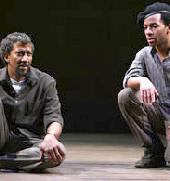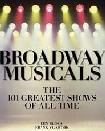SITE GUIDE
SEARCH
REVIEWS
FEATURES
NEWS
Etcetera and
Short Term Listings
LISTINGS
Broadway
Off-Broadway
NYC Restaurants
BOOKS and CDs
OTHER PLACES
Berkshires
London
California
DC
Philadelphia
Elsewhere
QUOTES
On TKTS
PLAYWRIGHTS' ALBUMS
LETTERS TO EDITOR
FILM
LINKS
MISCELLANEOUS
Free Updates
Masthead
Writing for Us
A CurtainUp Review
Blue Door
|
I can't not be black— Lewis
|

Reg E. Cathey and AndréHolland
(Photo: Joan Marcus)
|
Lewis (Reg E. Cathey) is an erudite black mathematics professor with a severe case of insomnia. Tormented by his inability to rationalize who he is and why the white woman he married has left him (presumably because he refused to attend the Million-Man-March). Lewis’s churning mind can’t keep his ancestors from having their say or recalling and reenacting incidents from their own lives from the time of slavery through Reconstruction. Wrestling with his own personal demons, proud of his intellectual/mathematical prowess, but insecure about his place in white academia, Lewis finds himself locked in a battle of cultural identity with family members of past generations, including an abusive father.
André Holland plays these troubled restless souls of both sexes who vivify the past and challenge Lewis’ conflicted feelings. Playwright Barfield covers a lot of territory, connecting family members to servitude on the plantation, being divided and sold at auction beaten, lynched and subjected to sexual abuse.
But while many such events have been duly denoted in text and expressed in oral history, Barfield’s play is filled with words that spin into near poetic riffs and define the past and the present philosophical and cultural attitudes of African-Americans in a unique and refreshing way.
While the structure combines monologue and duologue, the interplay between Cathey’s more defensive nature and Holland’s more aggressive posturing remains as a stirring emotional and passionate standoff. Barfield also uses plenty of humor that allows for the characters to be fully aware of the white audience ("You got a bunch of white people sittin’ up in your head").
Leigh Silverman’s direction is clever enough to keep the action fluid and the often exhilarating speechifying stoking our interest. However, she might have invented a less nebulous exit for the actors at the end of the play.
Despite his staid countenance, Reg E. Cathey, who appeared on Broadway in Julie Taymor’s The Green Bird and Off-Broadway in White Chocolate, reveals an amazing range of feelings. His resonant voice serves as the conduit into his mind— a brilliant one that nevertheless is in a state of disconnect with his race and heritage. Holland has found dramatic empowerment in the mannerisms and the speech of his various characters, as refined and retooled through generations of black culture. This is a wonderful showcase for this charismatic and versatile actor, a 2006 graduate of the NYU MFA Acting Program. The accomplished versatility with which Holland portrays the characters wonderfully serves as the catalyst through which Lewis confronts his despair and self-hatred.
Narelle Sisson’s grey set design is unobtrusive with a wooden plank floor that gives the actors plenty of space. Two desks and chairs are placed on opposite sides and minimally used. A square patch of tall grass in the rear of the stage adds a touch of green. But it remains for the greater stretches of re-implanted history and revalued identity that makes Blue Door an impressive play. The title refers to a family memory and a tradition stemming from the days in the slave quarters when the door was painted blue to "keep the bad spirits out and the soul family in."
LINKS
Second Line
|
Blue Door By Tanya Barfield Directed by Leigh Silverman Cast: Reg Cathey and Andrew Holland Scenic Design: Narelle Sissons Costume Design: Toni-Leslie James Lighting Design: Mary Louise Geiger Sound Design: Ken Travis Original Music: Daryl Waters Running Time: 1 hour 30 minutes Playwrights Horizons, 416 W. 42nd Street; 212 /564 - 1235 From September 28, 2006 to October 29, 2006; opening October 10 Tickets: $45.00; www.playwrighthorizons.org Review by Simon Saltzman based on performance October 18, 2006 |

Easy-on-the budget super gift for yourself and your musical loving friends. Tons of gorgeous pictures.

Leonard Maltin's 2007 Movie Guide

At This Theater
Leonard Maltin's 2005 Movie Guide

 >
>

